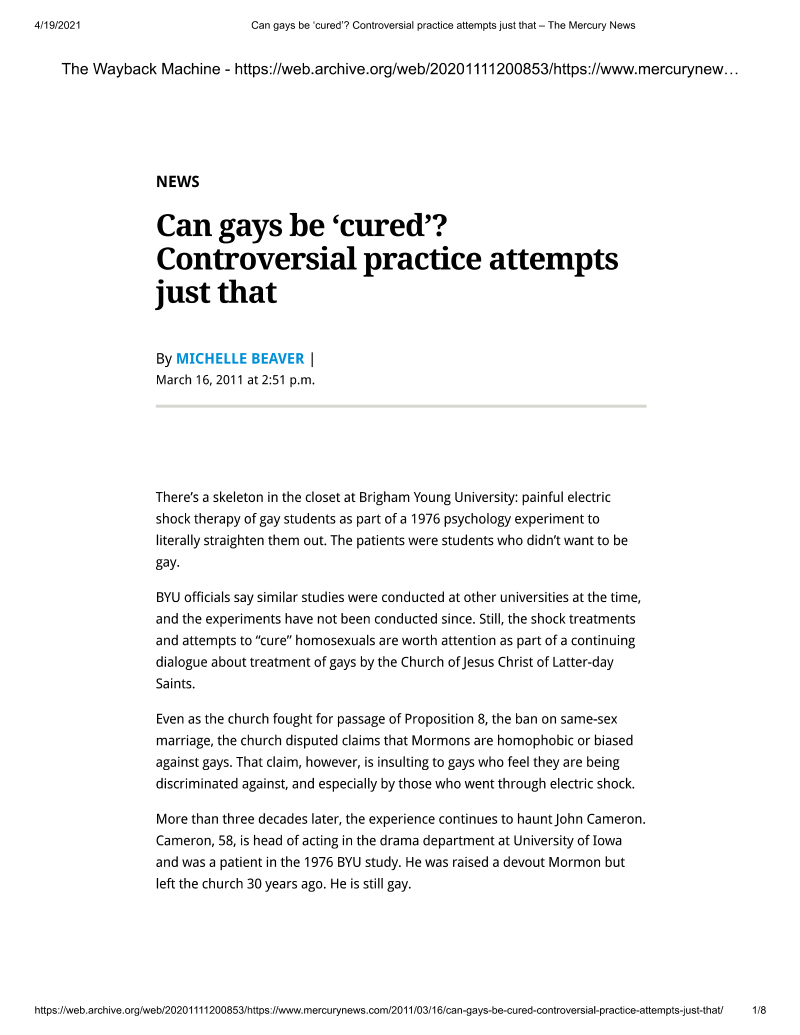Mercury News reports on John Cameron account of electroshock treatment at BYU.
- Type
- News (traditional)
- Source
- Michelle Beaver
- Hearsay
- 2nd HandJournalism
- Reference
Michelle Beaver, "Can Gays be 'Cured'? Controversial Practice Attempts to do Just That," Mercury News, March 16, 2011
- Scribe/Publisher
- Mercury News
- Audience
- Reading Public
- Transcription
More than three decades later, the experience continues to haunt John Cameron. Cameron, 58, is head of acting in the drama department at University of Iowa and was a patient in the 1976 BYU study. He was raised a devout Mormon but left the church 30 years ago. He is still gay.
Before the therapy, he and 16 other men who wanted to be straight signed papers informing them that damage to tissue or organs may occur, that they would be looking at sensitive materials (pornographic photos) that may be contrary to their values, and that BYU would be released from responsibility for any damage. Something similar to a blood-pressure cuff, called a “plethysmographic measure,” was attached to each man’s genitalia. If they became aroused by gay photos, their bodies were shocked by electrodes.
“For a year I thought (the electroshock) had some effect — I convinced myself that such was the case,” Cameron says. “But it didn’t change anything except increase my self-loathing. I didn’t know the ramifications of the experiment until years later.” The program used reparative therapy (also called change therapy), but that is not physical. Aversion therapy, a system for punishing undesired behavior, is where the electroshock was used. Each patient was subjected to 22, 50-minute sessions. The average duration of treatment was three months.
The dissertation says the shocks would result in “pain and anxiety,” and ranks the jolts on a numbered scale. They’re described with labels such as discrete, intense, tolerable and intolerable. Each patient started with lower levels and then graduated to more intense levels of pain as the experiment continued.
“At that time, such techniques were being studied at other universities and institutions,” BYU spokeswoman Carrie Jenkins says. “Studies of this type have not taken place at the university since then.”
“This methodology,” she added, “was an outgrowth of the behaviorist movement, which believed that any behavior could be modified. Our understanding is that most behaviorists no longer believe this is an appropriate treatment for those who are seeking change.”
Historian and former Mormon Connell O’Donovan, an administrator at UC Santa Cruz, says he went through aversion therapy at BYU, but as part of a program separate from the 1976 doctoral experiments. O’Donovan was born into the Mormon church and, at 15, told a leader he was gay. He was sent to counseling with his bishop and stake president.
“It was summer and school was out so they told me that I needed to go down to BYU for this program that would help me to become heterosexual,” O’Donovan says. He didn’t want his parents to know he was gay, so church leaders arranged it to look like he was going to genealogy research camp, he says. He stayed in BYU dorms.
“They explained to me that they would place a heparin lock in my wrist and hook an IV up to that, and I would be put in a room alone with a plethysmograph on my penis that would measure my physical arousal so that when I got an erection they would know,” O’Donovan says. —… They were going to show me this gay pornography, and using the IV they would inject a drug into me during the gay pornography to make me start vomiting. Then they would switch the pornography over to heterosexual sex and inject a euphoric drug into me to get me to associate euphoria with heterosexuality.”
Early in his treatment, he stopped showing up.
“I told them I couldn’t do it, and they gave me a ‘shame’ letter which I had to hand-carry back and give to my stake president telling him that I had refused to go through with the Lord’s program for my cure,” he says.
That particular program is not confirmed by BYU, but electric shock did take place at BYU, university spokeswoman Jenkins says.
- Citations in Mormonr Qnas
The B. H. Roberts Foundation is not owned by, operated by, or affiliated with the Church of Jesus Christ of Latter-day Saints.

